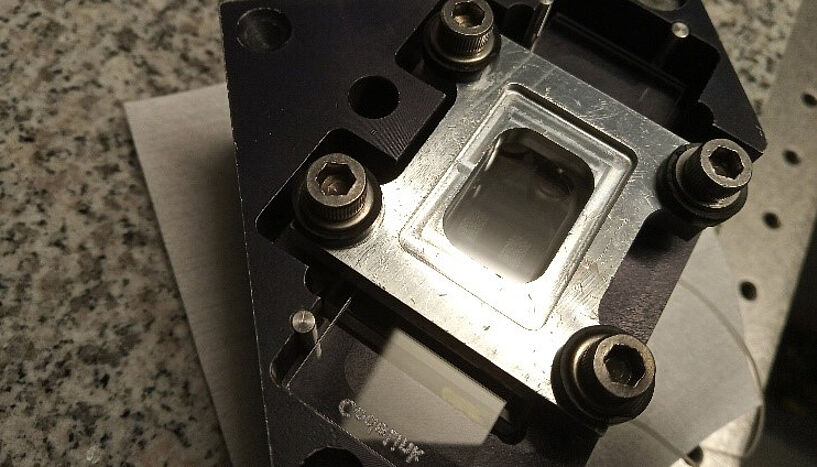Progress in bioanalytics: Production of RNA chips significantly simplified
25. July 2022
Abb. 1: Hardly visible to the naked eye: More than 300,000 different RNA molecules are bound in the center of this glass plate, here divided into four spatially separated sections. (© Erika Schaudy)
RNA chips can contribute to the exploration of new methods to diagnose and treat diseases such as cancer
Biochips (microarrays) are modern analytical tools that allow thousands of individual detections to be performed simultaneously in a small amount of sample material. A team led by Mark Somoza from the Faculty of Chemistry at the University of Vienna has now presented a new method in "Nature Communications". With this method, commercially available DNA chips can be quickly and easily converted into RNA chips, which are otherwise much more difficult to produce. Such RNA microarrays help to elucidate the still unknown functions of RNA molecules in cells - an important prerequisite for advancing the diagnosis and treatment of diseases such as cancer.
DNA and RNA are both nucleic acids; their best known tasks in our cells are the long-term storage of genetic information in the form of DNA, and RNA as an intermediate species in the biosynthesis of proteins. Commercially available DNA microarrays are used by default to perform high-throughput genome analyses. For example, they are regularly used in the diagnosis of various hereditary diseases and cancer. They consist of a solid carrier, for example a small glass plate, on which a large number of different DNA molecules are bound. The special feature is, on the one hand, that for each of these variants their exact position on the surface is known. On the other hand, they can be extremely densely packed, so that hundreds of thousands of different DNA strands can fit on the surface of a thumbnail.
RNA chip production has been difficult up to now
The commercial production of DNA chips is based on the stepwise concatenation of individual DNA building blocks. Although this production method has long been established, it can only be transferred to the synthesis of RNA microarrays to a limited extent. This is because RNA molecules are significantly more unstable. In addition, the individual RNA building blocks bind to each other with less efficiency than their DNA equivalents when building the RNA strand. This effect limits the possible length of the RNA strand. "However, to study the still unknown roles of cellular RNA molecules in particular, chips with significantly longer RNA strands are required than previously achievable with chemical synthesis of RNA microarrays. Our new method now solves this problem," explains first author Erika Schaudy, a young scientist in Mark Somoza's group at the Institute of Inorganic Chemistry at the University of Vienna.
Targeted use of enzymes makes it possible
As the Viennese research team has now shown, the DNA sequences available on commercial chips can be rewritten into their complementary RNA strands in a length-independent manner through the targeted use of enzymes. Further enzymes then selectively degrade the DNA templates resulting in an RNA chip.
"The outstanding thing is that the fabrication method we developed is based solely on commercially available materials and reagents. Specialized laboratory equipment is unnecessary. This now enables researchers from a wide range of disciplines to produce themselves RNA microarrays that are precisely tailored to their scientific questions," says Erika Schaudy.
Mark Somoza, who also heads a research group at the Leibniz Institute for Food Systems Biology at the Technical University of Munich, adds: "With this fast and easy-to-perform methodology, we have also created an important basis for further potential applications. For example, RNA technology could equally help to investigate the influence of food compounds on cellular processes and thus human health."
First author Erika Schaudy from the Institute of Inorganic Chemistry at the Faculty of Chemistry of the University of Vienna was one of 14 young scientists selected to present their research in the "Next Gen Science Session" at the recently concluded Lindau Nobel Laureate Meeting 2022. Her talk from June 27, entitled "Light-Directed Synthesis of Complex Nucleic Acid Libraries," can be viewed here: Video - Next Gen Science (2022) : Presentations by young scientists (lindau-nobel.org)
Publication:
Schaudy, E., Hölz, K., Lietard, J. & Somoza M.M. (2022). Simple synthesis of massively parallel RNA microarrays via enzymatic conversion from DNA microarrays. Nat Commun 13, 3772.
DOI: 10.1038/s41467-022-31370-9.
The open access publication is also featured in Nature Communications' "Editor Highlights": https://www.nature.com/collections/idhhgedgig
Picture:
Abb. 1: Hardly visible to the naked eye: More than 300,000 different RNA molecules are bound in the center of this glass plate, here divided into four spatially separated sections. (© Erika Schaudy)
Scientific contact
Dr. Erika Schaudy
Institut für Anorganische Chemie1090 - Wien, Josef-Holaubek-Platz 2 (UZA II)
+43-1-4277-52644
erika.schaudy@univie.ac.at
Assoz. Prof. Mark Somoza, Privatdoz. B.Sc. MSc PhD
Institut für Anorganische ChemieUniversität Wien
1090 - Wien, Währinger Straße 42
+43-1-4277-52643
mark.somoza@univie.ac.at
Further inquiry
Theresa Bittermann
Media Relations, Universität Wien1010 - Wien, Universitätsring 1
+43-1-4277-17541
theresa.bittermann@univie.ac.at
Downloads:
20220726_Schaudy_1_01.jpg
File size: 90,35 KB
